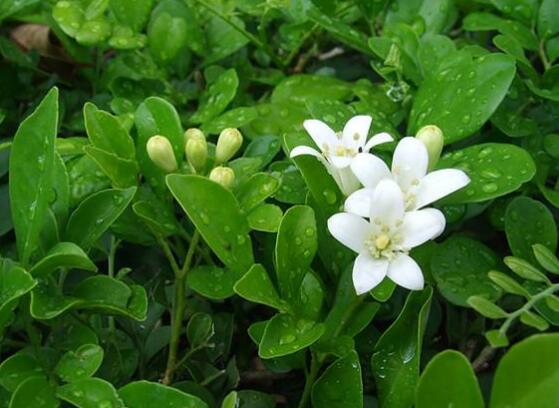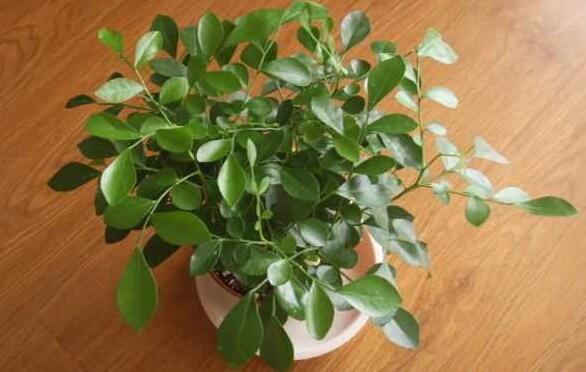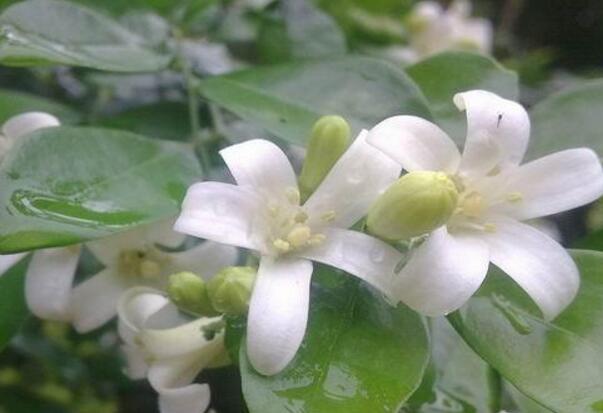How to fertilize Jiuli incense, make the leaves green and bright / the flowers bloom fragrant and big
Jiulixiang, also known as Qilixiang, was once the name of a song written by Jay Chou. It is very beautiful and has a strong fragrance of flowers, so it has a strong ornamental value. Nowadays, more and more people plant Jiuli incense at home, but if they want to raise it well and make it beautiful with green leaves and flowers, proper fertilization is very important. How to fertilize it? In this regard, the editor will briefly say a few points for you.
How to fertilize Jiuli incense, fertilizer types and nutrients

As a kind of flower with high ornamental value, the flower and fragrance of Jiuli incense attract people to plant it in their own home. However, the soil nutrients of potted Jiuli incense are limited, so in order for Jiuli incense to grow well, we need to supplement appropriate fertilizer. As for how to fertilize Jiulixiang, we should apply appropriate amount of fertilizer and pay attention to grasp the types of fertilizers and nutrient content. Let's move on to the next step.
2. Fertilization method of Jiuli incense
1. Soil selection
How to fertilize Jiuli incense in order to make it grow well, we need to start from the root-the soil. Jiuli incense likes fertilizer, before planting, we should choose the soil with high decay, and mix some bone meal or nitrogen, phosphorus and potassium compound fertilizer in it, which can be used for its early growth.
When you fertilize Jiuli incense, you can combine it with changing pots. In the culture method of Jiuli incense, we have mentioned that Jiuli incense usually changes the pot every 2-3 years. At that time, people will put the prepared bone meal, fertilizer cake and other nutrients at the bottom of the flowerpot, which can promote the good growth of the plant.
2. Fertilization time of Jiuli incense
In addition to careful care, it is very important to master the fertilization method of Jiuli incense if you want to raise the nine-mile incense at home. Fertilization is linked to time, and the amount of fertilization varies greatly in different periods of Jiulixiang, as follows:
1. During the growing period, Jiuli incense grows very fast and needs to consume a lot of nutrients. At this time, the number of fertilizers should be set at once a week, and the amount of fertilizer eaten can also be increased appropriately. The proportion of fertilizer and water is usually mixed at 4:6.
2. From April to June, 0.2% potassium dihydrogen phosphate solution can be sprayed into the leaves once a month to promote flower bud differentiation, and the remaining roots can be drenched.
3. Before flowering and budding, apply more phosphorus and potassium fertilizer, which is beneficial to more flowering and strong fragrance of flowers. Note: apply more fertilizer, but not too much, because if there is too much nitrogen fertilizer and lack of phosphorus and potassium fertilizer, Jiuli incense will grow branches and leaves without budding.
4. Fertilize normally during flowering and after budding. When fertilizing, pay attention to the combined application of nitrogen, phosphorus and potassium, do not apply nitrogen fertilizer alone, otherwise the branches and leaves will grow and not give birth to buds.
5. After the flowering period of Jiuli incense, we need to apply a small amount of fertilizer to it, and it is best to use fertilizer containing nitrogen and phosphorus, which can increase the number of flowering.
6. Stop fertilizing during the winter dormant period. In addition, if you fertilize the young trees, the amount mentioned above can be increased to accelerate their growth and development.
Third, matters needing attention in fertilization of Jiuli incense
Jiuli incense how to fertilize, read the above introduction, I believe we all know how to do it! However, in addition to mastering the method of fertilizing Jiuli incense, we also need to pay attention to the following points:
1. The liquid fertilizer applied by Jiuli incense should not be too thick, and it is best to use it after dilution, otherwise it is easy to produce fertilizer damage. Once the fertilizer is too much, the symptoms of yellowing of the leaves will appear. In addition, organic fertilizer and cake fertilizer must be fully mature before they can be applied.
2. For Jiuli incense, which has just been put into the pot, we should not think that fertilization can make it grow fast, because if the new root does not grow, fertilization is easy to be counterproductive.
3. When the Jiuli fragrant potted soil is dry, it should be watered after fertilization. If you put it outdoors, it is better to apply fertilizer before Jiuli fragrant rain, not on rainy days, and not to sprinkle liquid fertilizer and water on the leaves.
Generally speaking, Jiuli incense is so adaptable that it can blossom even if it is fertilized less. However, if you want Jiuli incense to grow well and bloom beautifully, it is crucial to master the method of fertilizing Jiuli incense. Only when all aspects of Jiuli incense are in place in the process of breeding Jiuli incense, can your Jiuli incense blossom with large and beautiful flowers.
How to fertilize Jiuli incense, so the leaves are green and bright!
How to apply fertilizer
If you want Jiuli incense to grow well, the first thing is to start with the choice of soil. before planting, you should choose the soil with high decay, and mix some organic fertilizer in it, which can be used for its early growth.
Fertilization can be carried out when changing pots, usually once every two or three years, and put the prepared bone meal, fertilizer cakes and other nutrients at the bottom of the flowerpot, which can promote the good growth of the plant.
Around May every year, this time is when the growth of Jiuli incense is more exuberant, the frequency of fertilization is usually once a week, and the amount of fertilizer used can be slightly higher than before. The proportion of fertilizer and water is usually mixed at 4:6. In addition, we can also add an appropriate amount of fertilizer to the surface of the basin soil, and some of the eggshell residues and rice water that we have used up can be used for watering. When the flowers of Jiuli incense are in bloom, we need to fertilize them with a small amount of fertilizer. it is best to use fertilizers containing nitrogen and phosphorus, which can increase the number of blossoms.
Matters needing attention
The use of fertilizer can reduce the concentration of Jiuli incense before use. if it is not diluted, it can easily affect the growth of Jiuli incense, and the plants newly installed in flowerpots do not have to apply fertilizer because they do not have new roots. Fertilization should be carried out in conjunction with watering when the basin soil is relatively dry, there is no need to apply fertilizer when it rains, a small amount of fertilizer can be used before the rain, and ammunition can be avoided spraying on the leaves.
How to water and fertilize Jiuli incense
Jiuli incense is not only a common evergreen shrub in our life, but also a favorite ornamental plant in family decoration. Jiuli incense is one of the most important potted plants in southern China, and its cultivation techniques have always been the concern of flower keepers. Today, combined with the growth habits of Jiuli incense, the editor made a simple summary of how to water and fertilize it.
How to water Jiuli incense
Jiuli incense is resistant to drought, large evaporation, afraid of stagnant water, watering to see dry and wet, watering too much, can cause rotting roots. It can be watered every 2-3 days in spring, the temperature is high in summer, and the water is watered once a day, which can fog the plant and its surroundings, increase the humidity of the environment, and lower the temperature. It can be watered once every 2 days in autumn and less in winter, but once every 7-10 days, often.
Jiuli incense watering should also pay attention to keep the basin soil moist. Before pregnancy, less water should be properly watered to promote bud differentiation, and normal watering should be done after the pregnancy camp and the previous period.
How to fertilize Jiuli incense
It is an ornamental shrub with good evergreen shade tolerance. During the period from March to October every year, especially the flowering and fruiting period, Jiuli incense needs more nutrition. During this period, due to the suitable temperature, large transpiration, large plant growth and consumption of nutrients, so the amount of fertilizer is also large, and fertilization is mainly concentrated in this period.
The fertilization of Jiuli incense should be based on the tree potential and leaf color step by step, with thin application and diligent application as the principle. Before the beginning of spring, burying rotten organic fertilizer in the soil to improve the soil aggregate structure in order to achieve the purpose of air permeability, fertilizer and water conservation as the base fertilizer, in order to meet the needs of annual plant growth. In the period of maximum plant growth, chemical fertilizer was applied according to leaf color and tree potential to meet the urgent need of plant nutrients in the maximum growth period.
The above is a simple summary of how to water and fertilize Jiuli incense. Jiuli incense, which is native to the south of China, has high requirements for light and should be exposed to direct light for 6 hours a day. Jiuli incense is not cold-resistant and does not like a cool environment, so it can be planted on the balcony or in the courtyard at home. The fragrance of fragrant flowers in Jiuli is overflowing, and the plants are short and beautiful. Friends who like them might as well plant one.
- Prev

How to raise Jiuli incense? the breeding methods and precautions / pruning of Jiuli incense are very important
Jiuli incense, a very beautiful plant, has a very strong aroma as its name, but it can spread nine miles away. It is deeply loved by flower friends and is often potted at home. With Jiuli incense becoming more and more familiar, many novices began to raise it. How to raise it?
- Next

When does Jiuli incense blossom? how long is the florescence of Jiuli incense / July and April
Jiuli incense, a kind of plant with beautiful plant shape, beautiful flower shape and strong flower fragrance, is often kept indoors and is loved by flower friends. However, Jiuli incense usually takes 3-4 years to blossom from sowing to flowering, so it is a question that everyone wants to know when it will blossom.
Related
- Fuxing push coffee new agricultural production and marketing class: lack of small-scale processing plants
- Jujube rice field leisure farm deep ploughing Yilan for five years to create a space for organic food and play
- Nongyu Farm-A trial of organic papaya for brave women with advanced technology
- Four points for attention in the prevention and control of diseases and insect pests of edible fungi
- How to add nutrient solution to Edible Fungi
- Is there any good way to control edible fungus mites?
- Open Inoculation Technology of Edible Fungi
- Is there any clever way to use fertilizer for edible fungus in winter?
- What agents are used to kill the pathogens of edible fungi in the mushroom shed?
- Rapid drying of Edible Fungi

